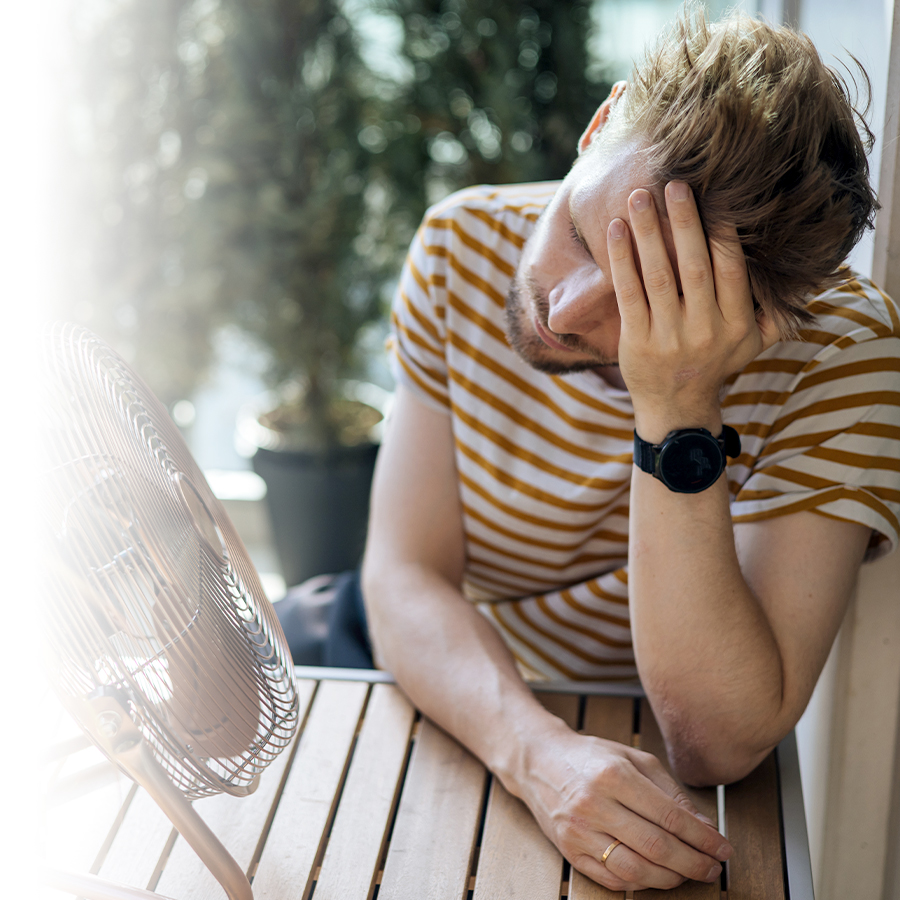In summer, you need to be aware of the risks of heatstroke and related problems, so you can avoid them.
Heat-related health problems
In summer, the hot sun rays do the body and soul a world of good. However, you need to be aware that excess heat and humidity can predispose you to, and even cause, health problems. Here are some examples:
- heat-related dermatitis
- swelling of the extremities
- heat cramps, and
- exacerbation of chronic illnesses (e.g., asthma, emphysema, chronic bronchitis, heart failure)
This text specifically focuses on sunstroke, heat exhaustion, and heatstroke.
Thermoregulation and loss of balance
The human body is equipped with certain mechanisms that maintain its internal thermal balance at roughly 37°C. A certain temperature variation can be tolerated by a healthy adult without really affecting them. However, during periods of scorching or extreme heat, the body may have trouble cooling down and maintaining its temperature within a normal range. This is especially true in the presence of the following factors:
- prolonged exposure to heat (and humidity)
- excessive physical exertion, and
- excessive sweating
When the body "overheats", this can lead to difficulties that are manifested by symptoms. In the worst cases, it can be life-threatening.
Sunstroke is caused by the irect effect of the sun on the head and most often occurs in children after direct sun exposure. It is characterized by intense headaches, nausea, drowsiness, fever, burned skin, etc. Loss of consciousness is possible.
Heat exhaustion occurs following excessive electrolyte (salt) and fluids loss caused by exposure to heat over a prolonged period. This leads to decreased blood volume and can cause symptoms such as: fatigue, weakness, nausea, vomiting, muscle cramps, insomnia, restlessness, dizziness, fainting, collapse, etc.
Heatstroke can occur when the body’s internal temperature rapidly increases beyond its control. This can happen as a result of sunstroke or heat exhaustion. If the body temperature reaches or exceeds 40°C, several symptoms are possible: hot, red, and dry skin, violent headaches, confusion, convulsions, fainting, coma, etc. Heatstroke is a medical emergency, and the risk of death must be considered.
Risk factors
Some people are more vulnerable to the effects of too much heat. For example, this is the case for the following people:
- babies and young children (under age 5)
- the elderly
- people who work outdoors (especially in the case of physical exertion)
- sports enthusiasts (e.g., marathon runners)
- people who are ill, disabled or losing their autonomy, and
- alcohol or drug users
Caution: taking certain medications can predispose a person to heat-related illnesses. For example, this can be the case for certain antihypertensive drugs and medications used for cardiac or psychiatric disorders. Ask your pharmacist for additional information.
Prevention
To prevent heat-related health problems, here are a few tips:
- Don’t exercise in very hot or humid weather.
- If you do exercise in these conditions, be sure to rest often and, above all, drink plenty of water (at least 6 to 8 glasses a day).
- Choose an appropriate time to exercise, such as early in the morning before temperatures rise.
- Wear loose-fitting and lightweight clothing.
- Don’t overexpose yourself to the sun or heat, whether you’re exercising or not.
- If necessary, seek shelter from the heat to help lower your body temperature.
- Look for air-conditioned areas.
- Take a cool shower or bath.
- Drink plenty of water.
- Avoid alcohol and caffeine.
- Get plenty of rest.
For vulnerable people (e.g., children, the sick or the elderly), additional measures should be considered. Ask your healthcare professional for advice.
Taking charge
If you suspect that someone is suffering from heatstroke, consult a healthcare professional promptly to confirm a diagnosis and ensure proper treatment. If there are even the slightest alarming symptoms or if in doubt, take the person to the emergency room immediately or call 911. This could be a medical emergency.
While waiting for clear instructions or the arrival of assistance, the following measures may help:
- Make sure the person is no longer exposed to heat or sunlight. Take them into the shade or to a cooler, ventilated or air-conditioned area.
- Avoid excessive air-conditioning, which could cause thermal shock.
- If possible, remove their clothes, especially if they are dressed warmly.
- Cool their body with lukewarm or cool water (not too cold), using a towel or washcloth. In less severe cases, a cool bath or shower can help lower body temperature.
- If the person is conscious, have them drink water in small sips to avoid dehydration, even if they say they're not thirsty.
- Encourage them to rest and adhere to treatment measures.
- Make sure they lie down with their legs elevated. If they are unconscious, place them in a safe lateral position (on their side).
Speak to your pharmacist for additional information on heat-related health problems and preventive measures.

